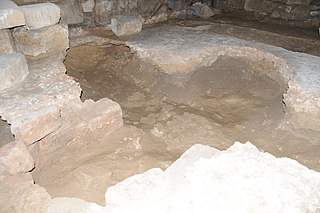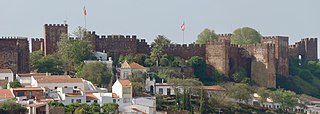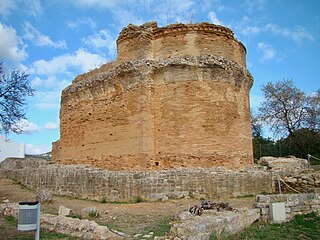
São Domingos de Rana is a civil parish of the Portuguese municipality of Cascais, part of the Greater Lisbon subregion. The population in 2011 was 57,502, in an area of 20.36 km². The parish includes the localities Abóboda, Cabeço de Mouro, Caparide, Matarraque, Outeiro de Polima, Polima, Rana, Talaíde, Tires, Trajouce and Zambujal.

Municipium Cives Romanorum Felicitas Julia Olisipo was the ancient name of modern-day Lisbon while part of the Roman Empire.
The Roman ruins of São Cucufate is a Romanesque archaeological site, located on the ruins of a Roman-era agricultural farm in the civil parish of Vila de Frades, in the municipality of Vidigueira, in the southern Alentejo, Portugal. The convent, which dates back to Middle Ages, was dedicated to the martyred saint Cucuphas.
The Roman ruins of Villa Cardillio is an archaeological site located in central Portugal. Situated in the rural civil parish of Santa Maria, it is located approximately 3 km from the centre of the municipal seat of Torres Novas. Receiving its name from a mosaic pavement onsite, the specific translation of piece is still unclear, but assumed that the site was owned by a couple. The ruins were first excavated in 1962, yielding hundreds of coins and well as ceramics, bronze works, Assyrian and Egyptian glass works. Also revealed were some jewellery and a statue of Eros.

The Monastery of Dumio, is a former paleo-Christian monastery in the civil parish of Dume, municipality of Braga, in northwestern Portugal. Originally a Roman villa, it was the base of a basilica by Suebi tribes, and later Christian monastery headed by Martin of Braga in the 6th century. The re-discovery of the Roman ruins in the late 20th century resulted in archaeological excavations that unearthed its former use.

The Castle of Silves is a castle in the civil parish of Silves in the municipality of Silves in the Portuguese Algarve. It's believed that the first fortifications were built upon a possible Lusitanian castro, by the Romans or Visigoths. Between the 8th and 13th centuries, the castle was occupied by the moors who expanded it, making it one of the best preserved Moorish fortifications in Portugal, resulting in its classification as a National Monument in 1910.

The Castle of Carrazeda de Ansiães, normally shortened to Castle of Ansiães, is a medieval castle in the civil parish of Lavandeira, municipality of Carrazeda de Ansiães of Portugal.
The Roman Ruins of Cerro da Vila are the remnants of a historical villa in the Algarve region of southern Portugal. Its vestiges lie in the vicinity of the resort and marina of Vilamoura, in the civil parish of Quarteira, municipality of Loulé Municipality.
The Roman villa of Vale do Mouro is a Roman settlement situated in the civil parish in the municipality of Meda, excavated since the early 21st century by archaeologists.
The Archaeological Site of Alto da Vigia is an archaeological site associated with Roman interventions in the Portugal, situated along the Praia das Maçãs in the civil parish of São João das Lampas e Terrugem, in municipality of Sintra.
The archaeological site of Colaride, is a Roman necropolis in a natural cave, located in the Portuguese civil parish of Agualva e Mira-Sintra, municipality of Sintra.

The Roman ruins of Casais Velhos are the remains of a Roman town, in the municipality of Cascais, lisbon District, Portugal that included baths, two cemeteries, remains of a wall and ceramic artifacts.
Roman villa of Alto do Cidreira is a Roman villa in the civil parish of Alcabideche, municipality of Cascais. Although known since the 1890s, this site has nonetheless been neglected by archaeologist conservationists, resulting in destruction of artefacts, that include Roman era mosaics, a bath complex and an olive oil cellar.
The Roman villa of Outeiro de Polima ) is a Roman villa in the civil parish of São Domingos de Rana, in the Portuguese municipality of Cascais, dating from the 1st to 6th centuries AD.
The Roman ruins of Frielas is a Portuguese archaeological site in the civil parish of Santo António dos Cavaleiros e Frielas, in the municipality of Loures.
The Roman villa of Quinta da Bolacha is a Roman villa in the civil parish of Falagueira-Venda Nova, municipality of Amadora, with an occupation dating from the 3rd and 4th century. It is commonly associated with the nearby Roman aqueduct, as well as the agricultural activities and Chalcedony mining occurring in the district.
The Roman Thermae of Maximinus, are the archaeological ruins of a monumental building and public baths, whose construction was integrated into the urban renewal of the civitas of Bracara Augusta, the Roman provincial capital of Gallaecia. The large public/civic construction consisted of a building, housing the baths, and a theatre, although the archaeological excavations continue.

The Roman villa of Freiria ) is a Roman villa in the civil parish of São Domingos de Rana, in the Portuguese municipality of Cascais.
The Roman Ruins of Pisões, is an important Roman villa rustica located in the civil parish of Beja in the municipality of Beja, in the Portuguese Alentejo, classified as a Imóvel de Interesse Público.

The Roman Ruins of Milreu are the remains of an important Roman villa rustica located in the civil parish of Estói in the municipality of Faro, Portugal, classified as a Monumento Nacional. The Milreu ruins constitute the most prominent and well preserved evidence of Roman presence in the Algarve, and are mainly composed of the remnants of a once luxurious villa with annexed thermae and several surrounding buildings, including a temple, mausoleum and industrial and commercial structures. The archaeological site still preserves part of the once exuberant mosaics that decorated the floor and walls of the villa. A 16th century house is also located in the area, alongside an interpretation centre.









